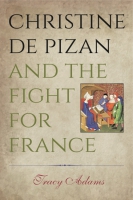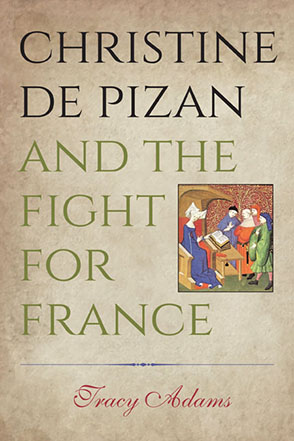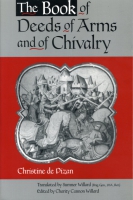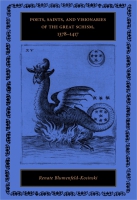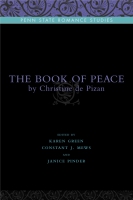Christine de Pizan and the Fight for France
Tracy Adams
“This book makes a valuable contribution to Christine studies and related fields in its convincing presentation of many exhilarating ideas and approaches to familiar but underquestioned material while introducing new sources. The careful notes, bibliography, and detailed index are all attractively produced. A pleasure to read, it is highly recommended for levels ranging from undergraduates to specialists in French history and literature.”
- Description
- Reviews
- Bio
- Table of Contents
- Sample Chapters
- Subjects
“This book makes a valuable contribution to Christine studies and related fields in its convincing presentation of many exhilarating ideas and approaches to familiar but underquestioned material while introducing new sources. The careful notes, bibliography, and detailed index are all attractively produced. A pleasure to read, it is highly recommended for levels ranging from undergraduates to specialists in French history and literature.”
“This clear and thorough narrative of Christine's engagement with the conflict will be of value to historians and literary scholars alike.”
“A short review does not do justice to the significance of this work. Adams successfully situates (’rehistoricizes’) a multifaceted literary figure into an extraordinarily complex period in French history, and does so with clarity and sensitivity, providing a most helpful and stimulating resource for scholars and students.”
“This book is very much one to keep at one’s elbow in any undertaking concerned with the closing phases of the Hundred Years War; it compels the reader to consider alternate ways of thinking. Adams’s latest contribution to the field will appeal to Christinian scholars and others interested in French history, the politics and literature of political crisis, rumour and propaganda, monarchy, queenship, gender and gendered discourse.”
“[Tracy] Adams has given us a sophisticated presentation that in turn happily gives us a much more complex Christine, but one that could be more complex still by integrating the political Christine back into the humanist and poet Christine. Readers, nonetheless, will find much in this little volume of value that integrates Christine’s writings into her fraught and troubled world, and shows us how integrated this world was with Christine’s mind.”
“Adams’s analysis is original and deserves to be widely read.”
“By opening up her literary production to a fresh set of interpretive possibilities, and by asking readers to question their assumptions and accepted narratives about Christine’s relationships to the powers of her day, Adams offers a welcome contribution to late medieval literary scholarship.”
“In an earlier book, Tracy Adams did great service to the scholarly community by helping dispel the outdated, slanderous fictions surrounding the lives of Isabeau of Bavaria and Louis of Orleans. In this work she continues to apply recent historical research to the task of developing new readings of Christine de Pizan. The result is an up-to-date and very readable history of the conflict between the Burgundians and Armagnacs that offers insightful readings of all of Christine's major works and enhances our understanding of her allegiances and the ways in which her texts responded to the conflict.”
Tracy Adams is Associate Professor of French at the University of Auckland.
Note on Translations and Manuscripts
Acknowledgements
Prologue
Chapter 1: Christine and the Armagnac-Burgundian Feud: Kingship and Regency
Chapter 2: The Beginnings of the Feud and Christine’s Political Poetry, 1393-1401
Chapter 3: The Point of No Return and the Political Allegories, 1401-1404
Chapter 4: The Entrance of Jean of Burgundy and Reconfiguring Regency, 1405
Chapter 5: Heading Toward Showdown and the Prose Treatises, 1405-1407
Chapter 6: The Great Feud, After 1407
Epilogue
Notes
Bibliography
Index
Prologue
The feud between the Orleanists, or Armagnacs, and Burgundians, that “sickness that so tears through the land” brought on by mad King Charles VI’s inability to reign, is a central theme in Christine de Pizan’s corpus. An observer of the strife, Christine laments the conflict’s devastating material effects on her society throughout her career.
And yet her literary engagement with the feud, her use of “literature as a potent social mediator” to influence the course of the conflict, has received little attention. Although scholars acknowledge Christine de Pizan as one of a group of fifteenth-century political writers to treat “immediate reality and, consequently, what one can call contemporary history,” attention to date has focused more on what she said about women, authorship, and authority, and, in the abstract, kingship, peace, and warfare, than on how she sought to influence her immediate political situation. Scholars who have considered her engagement with contemporary politics have relied heavily on superseded histories, creating a confused narrative of her political loyalties and goals. The poet is depicted as politically neutral (“Christine de Pisan hated factions and had no sympathy for partisan politics”) and/or fickle, switching sides from the Orleanists to the Burgundians and back again. No one disputes that by the second decade of the fifteenth century she was an ardent Armagnac, as the Orleanists were called after 1410, fleeing Paris along with fellow Armagnacs fortunate enough to escape the Burgundian massacre of 1418, and celebrating the triumph of the Armagnac leader King Charles VII in the 1429 Ditié de Jehanne d’Arc. But many scholars place her in the Burgundian camp before this, after a still earlier flirtation with the Orleanists. This narrative has her soliciting the patronage of the brother of the mad king, Louis, Duke of Orleans, regent during the king’s episodes of insanity, but, irritated by a slight (Louis is supposed to have refused to find a place for her son in his household) and disillusioned with his profligacy, she abandons him to become a discreet propagandist for the king’s uncle, Philip of Burgundy. Although some believe that she was less enthusiastic about Philip’s successor, the notion that after Jean sans Peur (the Fearless) succeeded his father as Duke of Burgundy in 1404, Christine remained in her “secure seat in the Burgundian camp” as a “paid Burgundian propagandist” continues to hold force. The most widely read biography of the poet in English reports the presumed shifts of allegiance without comment, slipping in the space of one paragraph from “Christine had enjoyed the patronage of two dukes of Burgundy,” to “her son was now one of the dauphin’s [the future Charles VII’s] secretaries,” to Christine’s “family was fortunate to escape [the Burgundian massacre] with their lives.”
The incoherence results from a narrative of political activity at Charles VI’s court developed by historians influenced by the ideals of the French Revolution, a narrative itself derived from Burgundian propaganda circulated after Jean of Burgundy’s assassination of the Duke of Orleans in 1407. Republicans like Louise de Kéralio uncritically adopted Burgundian images of the king’s brother and the queen as greedy wastrels, and that of the dukes of Burgundy as men of the people. In her 1791 diatribe on the queens of France, Kéralio paints Queen Isabeau as an early Marie Antoinette and Louis as the Count of Artois. This narrative passed into the works of nineteenth-century historians: Michelet, Guizot, Martin, Coville, and Thibault reinforced the pair’s negative reputation. True, monarchist historians viewed Louis positively (although they were less favorable toward Isabeau), but they were few in number compared to their Republican counterparts.
The 1838 essay by Raimond Thomassy, an early scholar of Christine’s political thought, manifests these Burgundian biases. Thomassy writes of Louis of Orleans that, “as brother of the king, he claimed to be invested with principal authority to govern during the illness of Charles VI,” as if the duke had no legitimate claim to regency. Moreover, Thomassy asserts that Louis “destroyed the people with exactions, dilapidated without shame the public treasury,” without mentioning that the taxes were for the war with England or that such complaints were routinely leveled for political reasons against anyone possessing the right to tax. By contrast, Thomassy describes Philip as the “heir in wisdom and determination of Charles V.” As for Isabeau of Bavaria, the odious queen “brought shame and infamy to sit on the throne of France and betrayed at the same time her feminine, maternal, and wifely duties.” Nor is it widely understood that the assumption that the queen suffered from a bad reputation during her lifetime is based on four unflattering comments in the chronicle of Michel Pintoin, the Burgundian-biased monk of St. Denis, all from the same year in which Jean of Burgundy first tried to seize control of the mad king. And it is rarely acknowledged that evidence for the unpopularity of Louis of Orleans comes primarily from the same source, along with another anti-Orleanist chronicle, that of Pierre Cochon, and the justification of Louis’s assassination pronounced by Jean Petit on behalf of Jean of Burgundy. Even recent Christine scholarship continues to show the influence of the Burgundian narrative, drawing an equivalency between Louis’s regency claim and the attempts of the dukes of Burgundy to seize control of the government, seeing both as the “usurpation of power by the king’s brother, uncles and nephews.” About Christine’s view of the Duke of Orleans, we read that it is “evident that she wanted [him] in particular to take heed” of her writings on prudence. Philip of Burgundy, by contrast, was “an effective diplomat as well as a sound military adviser,” and, more important, functioned as “a moderating force in the polemical atmosphere of the court.” Isabeau, Charles VI’s “beautiful, sluttish wife,” “encouraged” him “in his taste for pleasure.” King Charles VI is imagined to have been reduced to rags while his family members pillaged the treasury to support their own luxurious lifestyles; gossip circulated about “the relations between the queen and the duke of Orleans, a liaison that lasted until the duke’s assassination in a Paris street near the queen’s residence in November 1407.”
This study rereads Christine’s major works from a perspective informed by recent historical scholarship on the Armagnac-Burgundian feud. Because the views of Burgundian chroniclers represent just one of several contemporary feud narratives, I widen the set of documents generally relied on to reconstruct Christine’s historico-political context. My argument, laid out in the following chapters, is that when Christine’s works are reread within this broader context—that is, when the Burgundian images of Louis, Isabeau, and Philip are recognized as propaganda and supplemented with other sources—it becomes clear that the poet’s many narrative voices consistently support the Orleanists. She is of necessity discreet, but she does indeed “challenge the particular interests of the princes,” at least the Burgundian princes. Such a claim requires untangling two frequently confounded perspectives on the poet’s political interactions: first, her beliefs about regency, which follow from her view of kingship, and second, her interactions and personal friendships with noble patrons. Flattery of Philip of Burgundy has often been assumed to be tantamount to promoting his regency claim. As I hope to show, however, Christine’s conception of regency was motivated by principles that remained steadfast throughout her career.
Furthermore, I hope to show that Christine intended her interventions in the conflict to produce effects. Studies by scholars like Larry Scanlon and Alan Cottrell on auctoritas and potestas offer useful terms for conceptualizing Christine’s method. Two of Charles VI’s relatives, both of them powerful, claimed regency during the king’s periods of madness. The question was which one possessed the authority necessary to realize his claim. Had clear laws existed for dealing with the emergency of Charles V’s madness, the regent would have possessed both power and the authority necessary to govern. But not only did no widely accepted regency plan exist; the very notion of kingship was still sufficiently vague to allow both Philip and Louis plausibly to press their claims. To paraphrase Scanlon, for Christine and contemporary political writers, kingship (and by extension regency) was not a fully formed institution but rather a “dynamic political structure” attempting to define itself ideologically. In rallying support behind Louis, I argue, Christine participated in fixing the definition of kingship. As the situation between the dukes worsened, Christine sought for a time to augment the queen’s authority, promoting Isabeau as the face of the regency while continuing to create authority for Louis as its force. Thus Christine also profoundly affected female regency as it developed in France from the fifteenth through the early seventeenth century. After Louis’s assassination, she continued to legitimize the Orleanists. She was always cautious: the Burgundians were not only important patrons but, particularly after Jean’s seizure of power in late 1409, extremely dangerous enemies. Only when Jean was temporarily disgraced and fled Paris after the Cabochian revolt did Christine openly throw her influence behind the dauphin, Louis of Guyenne.
Mailing List
Subscribe to our mailing list and be notified about new titles, journals and catalogs.
